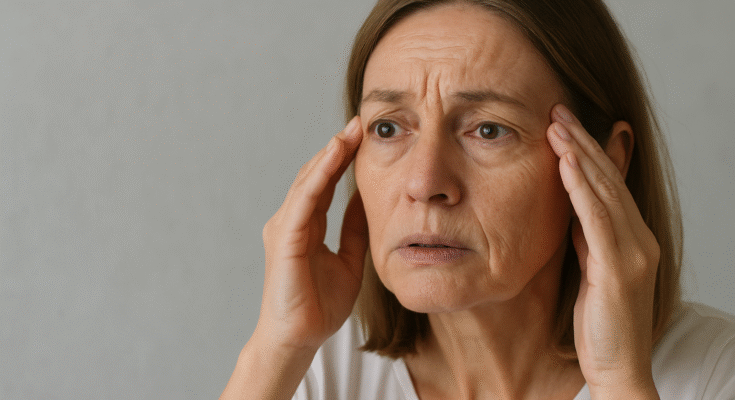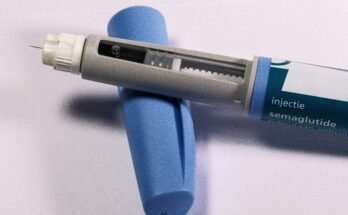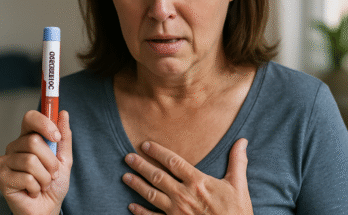Ozempic is a weekly injection that helps people with type 2 diabetes manage their blood sugar levels. It contains semaglutide, which acts like a natural hormone called GLP-1 (glucagon-like peptide-1). This helps lower blood sugar and also decreases appetite, so people often eat less and lose weight. Ozempic is made by Novo Nordisk and comes as a liquid solution in prefilled pens made for single-patient use. A healthcare professional can teach you how to inject it properly at home.
Even though Ozempic is meant for diabetes, many doctors now prescribe it for weight loss too. This is sometimes called off-label use. In the United States, the FDA has approved another version called Wegovy for weight loss. There’s also Mounjaro, which uses both GLP-1 and GIP hormones. These treatments are used for obesity and have received a lot of media coverage.
But some people have noticed a side effect. Their face starts to look thinner, with hollow cheeks, extra skin, or less fat. People call this “Ozempic face” and it’s becoming more common as the drug grows in popularity.
Here’s how to prevent it:
- Talk to your doctor about your dosage. Losing weight slowly can give your skin time to adjust and protect your facial appearance.
- Eat healthy foods to support your skin and body while losing weight.
- Make sure you’re using the injection pen the right way. Your doctor or nurse can guide you.
- Try basic face exercises, use good skincare, or ask a specialist if you’re worried about hollowness or loose skin. Some people even explore safe cosmetic treatments to bring back fat to the face.
In the UK, Ozempic is only licensed for diabetes. But many have heard about people using it for weight loss. Whether you’re using Ozempic, Wegovy, Mounjaro, or another brand, it’s important to understand how it might affect your body.
Always follow your prescription and check with a healthcare professional if you have any concerns. These medications can be effective, but they should always be used for the right purpose and with proper guidance.
What is Ozempic face?

When people lose weight quickly, especially with medications like Ozempic, Wegovy, or Mounjaro, their face can start to look different. These drugs are meant to promote rapid and effective weight loss, but they can also lead to noticeable facial changes. This is often called Ozempic face, not an official medical term, but a way to describe a distinct appearance that happens when the fat under the skin gets smaller. This fat usually helps keep the face full and smooth. Without it, the face can look hollowed, gaunt, or older than before.
As we age, our skin naturally loses elasticity, and when we drop weight fast, the skin doesn’t have enough time to react or adapt. This makes the change in our appearance even more obvious. Even if you’re using a healthy lifestyle instead of GLP-1 receptor agonists, the same thing can occur. The result is often a slimmer, but more tired-looking face. Knowing this ahead of time can help you take steps to care for your skin and slow these changes.
What does Ozempic face typically look like?
As an expert in weight management and aesthetic medicine, I’ve observed that patients experiencing rapid weight loss, especially from medications like Ozempic, often see visible changes in their face. This includes sunken areas around the cheekbones and temples, dark circle under the eyes, and sagging skin around the jawline, neck, and jowls. These effects are tied to an abnormal distribution of fat within the face, which can alter the size of the cheeks, chin, and lips. Combined with increased facial wrinkles, these shifts may make you look older than expected.
Clinically, I recommend patients aim to lose weight more gradually, as this can limit the appearance of these outcomes. That’s because gradual weight loss gives your skin essential time to adjust and retain elasticity. While some wrinkles and loss of volume are inevitable, pacing the process and supporting it with proper hydration, nutrition, and skin care can significantly reduce the facial aging effects tied to Ozempic-induced weight reduction.
Why do GLP-1 medications cause facial changes?
People using Ozempic, Wegovy, or Mounjaro, which are part of a group called GLP-1 medications, often see changes in their face after losing weight fast. What happens is that the fat under the skin starts to go away quickly, making the face look more hollowed or even gaunt. This look is often referred to as “Ozempic face.” It’s not just Ozempic, any quick weight loss can do this.
According to clinical studies, people taking Wegovy lost an average of 15% of their body weight in 68 weeks, and those on Mounjaro lost 22.5% over 72 weeks. That’s a significant drop in a short time. Losing fat this fast can make the skin look older. That’s why experts often recommend going slow, about 1 to 2 pounds per week, to avoid these facial changes and get healthier, more sustainable results.
In one study, people who just followed a calorie-controlled diet and did 150 minutes of weekly exercise alone lost only 2.4% of their starting weight in the same time. But those who combined diet, exercise, and medications lost a lot more. So yes, medications work faster, but slowing things down can protect your face.
The reason your face changes has to do with how your body reacts. You lose white adipose tissue (that’s just fat under the skin), and the number of fat-derived stem cells drops. At the same time, your body alters how it makes and releases hormones and metabolic factors. All of this affects the structure and function of your skin, reducing muscle mass and making the signs of ageing more visible.
Ozempic off-label use for weight loss
In recent years, the buzz around Ozempic has gone beyond treating diabetes. It’s now a hot topic in the world of weight management. While the FDA has approved this drug to treat type 2 diabetes, some doctors are prescribing it off-label for people seeking to lose weight. This means using it for a purpose not officially backed by the FDA, and though some experts see potential benefits, others warn that the side effects could outweighs the reward. The risk of facial volume loss, now commonly called “Ozempic face”, is one such concern that has raised red flags, especially in sensitive cases like type 1 diabetes, where it hasn’t been studied enough.
Since Ozempic belongs to the same class of medications aimed at improving blood sugar, using it for non-diabetic conditions is still debated. Some experts argue that prescribing it to people with type 1 diabetes might not be safe, and the effects of long-term off-label use are still being evaluated. If you’re considering this route, always consult a provider who fully understands the drug, its intended purpose, and the risk of changes to your face and body. Managing expectations and being cautious with weight loss strategies will go a long way in preventing these unwanted outcomes.
How to prevent or treat Ozempic face
You can prevent or manage Ozempic face in a few different ways, including:
1. Gradual weight loss
When trying to lose weight using GLP-1 medications like Wegovy or Mounjaro, one key thing I’ve learned is the importance of going at a slower, more gradual pace. Rushing weight loss might bring extreme effects, including facial volume loss, often called Ozempic face. I always tell clients to talk to their doctor about adjusting their dosage to what feels right. If you’re comfortable with a lower dose, there’s no need to stick to the maximum or push higher just for the sake of speed. A slower route not only protects your face but makes the whole journey feel more sustainable.
Personally, I’ve seen better long-term results by titrating up slowly and staying consistent with a balanced plan. Some patients find success by using maintenance levels instead of jumping to the maximum right away. Whether you’re on Wegovy, Mounjaro, or another GLP-1 medication, it’s not just about losing pounds, it’s about doing it with care. That’s why I always recommend customizing your medication plan and staying in sync with your body’s signals. A smart dose and steady pace can really make a difference in avoiding unwanted side effects.
2. Follow a balanced diet
If you’re using a GLP-1 agonist for weight loss, it’s important to follow a calorie-controlled diet that helps your body lose fat the right way. Make sure you’re eating the correct amount of food, not too little, not too much, because the right amount of calories can aid your journey and keep your face from looking tired or saggy. Focus on eating foods that give you good nutrition, like fruits, veggies, and proteins, while getting enough to keep your body strong. By ensuring you’re eating a well-controlled diet, you’ll stay on an effective path to lose weight without hurting your looks.
3. Eat more protein
From a clinical perspective, increasing protein intake is essential for maintaining facial volume and muscle tone, especially during weight loss with Ozempic. Patients are advised to prioritise protein-rich foods such as lean meat, fish, eggs, nuts, tofu, and edamame to help support both skin elasticity and underlying structure. Adequate protein not only aids in building and preserving muscle, but it also serves as a vital source of energy, which contributes to overall well-being and helps minimise the visible effects of rapid fat reduction.
4. Stay hydrated
One simple way to avoid looking tired or older while losing weight on Ozempic is by drinking plenty of water every day. Staying hydrated is essential because it helps your skin stay smooth and firm. When your body doesn’t get enough water, you may face dehydration, which makes your skin dry and weak. Drinking water supports your skin’s ability to maintain its elasticity and plasticity, meaning it can bounce back instead of sagging or looking loose.
I’ve seen people who drink enough water have better results with their skin staying tight during weight loss. Water helps your skin return to its original shape after stretching, which is really important if your face is slimming down. So, making water a part of your daily routine is a small but powerful step in preventing Ozempic face.
5. Exercise
As a health expert working closely with patients on GLP-1 medications, I often emphasize the important role of physical activity in preventing facial volume loss. Engaging in regular movement for at least 150 minutes per week is a key contributory factor not just for weight loss, but also for maintaining muscle integrity beneath the skin. This routine helps to tone facial and body muscles, leading to a more leaner, sculpted appearance that counters the hollow look sometimes seen with rapid weight reduction.
In addition to full-body workouts, I recommend facial exercises specifically designed to stretch and activate the delicate muscles in the face. These targeted movements can help slow down visible signs of ageing by reinforcing the structure that supports the skin. Many of my clients have found that combining aerobic activity with facial toning strategies makes a noticeable difference in maintaining a youthful and healthy look.
6. Make positive lifestyle changes
To keep your face looking fresh while on Ozempic, it helps to make smart everyday choices. Eating a good diet filled with healthy foods and staying active with regular exercise can make a big difference. Simple lifestyle changes like quitting smoking, cutting back on alcohol intake, and getting enough restful sleep help your skin stay firm and smooth. These small steps can promote healthy ageing and keep your face from looking tired or hollow as you lose weight.
7. Use skincare products
To help reduce the early appearance of facial sagging from fast weight loss, it’s smart to use good skincare habits with the right products. I’ve seen how using moisturisers every day keeps your skin soft and full, while adding collagen-promoting creams can improve the elasticity of your face. This can slow down the look of wrinkles and keep your natural glow.
8. Take supplements
One thing I’ve consistently observed in patients undergoing GLP-1 therapy is that preventing Ozempic face requires more than just external care, it starts with internal support during weight loss. As the face loses volume, the skin can show early signs of ageing, which is often associated with reduced collagen and elasticity. That’s why I strongly recommend collagen supplements to improve firmness and elasticity. To further promote overall skin health, I advise a combination of Multivitamins, protein supplements, and probiotics, which work synergistically to reduce the visible impact of fat loss on facial appearance.
9. Wear sunscreen
Using sunscreen every day really helps your skin look healthier and younger. Research suggests that regular use of sunscreen prevents early signs of ageing, which can happen faster with fat loss. To get the most benefit, always choose a sunscreen with at least SPF 15, since that’s the minimum protection factor that blocks damage from the sun. This keeps your skin firm and smooth, which is super important when you’re trying to avoid the tired, sagging look that some people call “Ozempic face.”
Will Ozempic face go away?
It can be surprising to see your facial appearance shift as you make progress with Ozempic. Many people start noticing a slimmer face, sometimes even looking a bit gaunt, as they lose weight. This happens because GLP-1 medications like Ozempic work fast, and with rapid loss of fat, especially around the cheeks, your face naturally changes. If you ever stop taking the medicine, some of that weight may come back and your face could return to how it looked before but keep in mind that this comes with other health implications.
You don’t have to choose between your health and your appearance. There are simple, effective treatments that include fillers, dermal injectable gels to smooth out wrinkles, and plump up areas that have lost volume. A newer option is microneedling, where tiny needles help stimulate collagen production, improving sagging and making your skin tighter. Other non-surgical fixes like radio waves also help tighten and improve the texture of your skin over time.
If you want more lasting changes, some people look into plastic surgery. A face or neck lift can tighten loose tissues and muscles, and cheek implants can make the cheeks look fuller again. Whether you choose a cosmetic procedure or just let things adjust naturally after the medication, it’s best to speak with a doctor before making any big decisions.
What happens after stopping Ozempic?
When you stop taking Ozempic, your body can go through some changes. A 2022 study done by a Trusted Source followed 1,961 participants over 1 year of semaglutide treatment. It showed that many people began to regain lost weight after stopping the medicine. This often happened because of increased cravings, blood sugar spikes, and the absence of the drug’s effect on the metabolic system. Without Ozempic, your hunger can return stronger, and it may be harder to control your eating.
In simple terms, stopping Ozempic doesn’t just bring back weight. It can also bring back risk factors like high blood pressure. Some side effects might go away, but the chance of gaining weight again is real. That’s why staying active and eating well is key, especially if you want to keep your face from looking tired or saggy after weight changes.
When to contact a doctor?
Sometimes, while managing weight and preventing Ozempic face, people forget how important it is to look out for severe side effects. If you’re on this medication and start noticing anything unusual, don’t wait—tell your doctor right away. Be sure to document your symptoms, no matter
how small they may seem, and share them clearly. There is a boxed warning tied to Ozempic because of a risk of thyroid cancer, which came up in animal studies. These studies showed an increased chance of this condition in animals who took semaglutide, the active drug in Ozempic. Although it’s not known for certain if this applies to humans, it’s better to stay cautious than try to predict outcomes.
If you feel a lump in your neck, have difficulty swallowing, feel pain, experience wheezing, shortness of breath, or notice your hoarse voice worsens with time, these are all strong signals that should not be ignored. These may be linked to complications beyond just facial appearance changes and could be more serious. Always stay alert and listen to your body while continuing efforts to avoid Ozempic face safely and smartly.
FAQs
1. How to avoid Ozempic face naturally?
One significant factor behind the development of Ozempic Face is losing weight too fast. When you go through rapid weight loss, your skin doesn’t get enough time to adjust, which may lead to a tired or gaunt appearance. The best approach is to aim for a steady and gradual drop in weight. This minimizes the impact and reduces the risk of your face looking sunken. Slow changes allow your body to react better and your skin to tighten naturally.
2. Can Ozempic face go away?
Facial changes like drooping are a common side effect of Ozempic usage, but they aren’t always permanent. If someone stops taking Ozempic yet maintains weight loss, the skin can gradually retract and even regain fullness. Over time, the face adjusts to its new shape, though it may look slimmer than before. Yes, recovery is possible.
3. How to hide Ozempic face?
The Ozempic face usually happens because of rapid weight loss, not the medication itself. To cover it up, go for fillers, gentle skin-tightening procedures, and daily skincare. Drinking enough water, eating a protein-rich diet, and getting the right medical treatments help you reduce the look of it and improve your facial appearance.
Final thoughts
If you’re taking Ozempic, Wegovy, or Mounjaro, it’s important to know that the so-called “Ozempic face” isn’t a direct side effect of these approved medications. It’s usually caused by rapid weight loss, which changes your body and facial appearance. But the health benefits of losing weight still far outweigh the aesthetic effects.
To limit the chances of experiencing changes in your face, you can take steps like adapting your journey to promote gradual weight loss, ensuring you’re hydrated and eating a protein-rich diet. Also, prioritising good skincare and exploring non-invasive cosmetic treatments can improve your appearance over time. These small changes offer powerful support during your transformation.
If you’re concerned, it’s always smart to speak with your doctor. They can help you devise a personalised plan that fits your goals while protecting your health and appearance. With the right support, your general outlook and self-image can thrive while still enjoying the full benefits of the medications you’re using. It’s about taking care of your whole self while embracing the experience.

James Rowen is a certified medical writer and healthcare researcher specializing in endocrinology and metabolic health. With over a decade of experience analyzing weight management therapies, James has developed deep expertise in GLP-1 receptor agonists, including Ozempic.




